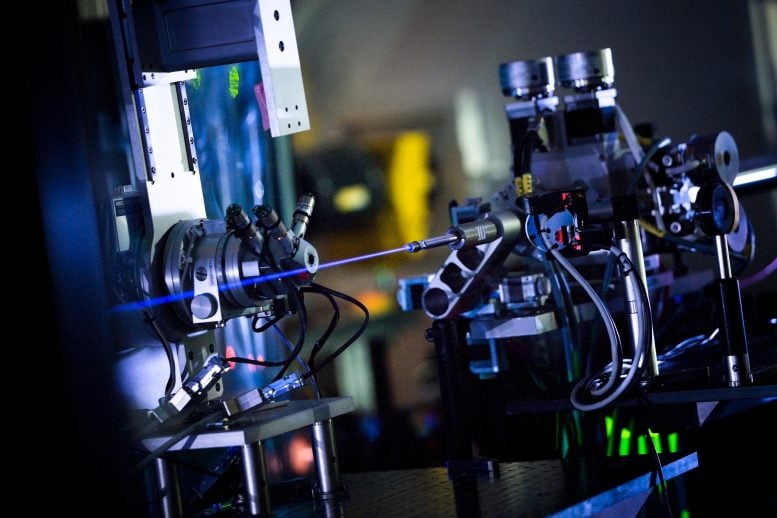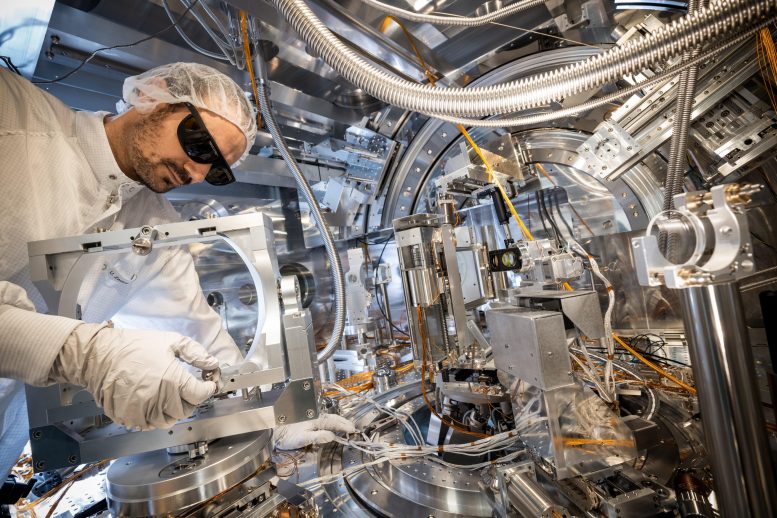A new experiment challenges quantum electrodynamics


The X-ray beam from the world’s largest X-ray laser, the European XFEL, becomes clearly visible as in the image in complete darkness with an exposure time of 90 seconds. In 2024, the first experiments to detect quantum fluctuations in a vacuum will be conducted here. Source: European XFEL / Jan Housan
The HZDR team proposes improvements to an experiment aimed at exploring the frontiers of physics.
Completely empty – that’s how most of us imagine emptiness. However, they are actually filled with energetic flashes: quantum fluctuations. Scientists are currently preparing to conduct a laser experiment aimed at investigating these vacuum fluctuations in a new way, which could potentially provide clues to new laws of physics.
A research team from the Helmholtz Center Dresden-Rossendorf (HZDR) has developed a series of proposals designed to help conduct the trial more effectively – and thus increase the chances of success. The team presents its findings in the scientific journal Physical review d.
The world of physics has long recognized that the vacuum is not completely empty but full of vacuum fluctuations — ominous quantum blips in time and space. Although it cannot be captured directly, its effect can be observed indirectly, for example, through changes in the electromagnetic fields of small particles.
However, it has not yet been possible to investigate vacuum fluctuations without any particles present. If this can be achieved, one of the fundamental theories in physics, quantum electrodynamics (QED), will be proven in a hitherto untested area. However, if such an experiment revealed deviations from the theory, it would indicate the presence of new particles that have not been discovered before.

Dr. Ulf Zastrau heads the HED (High Energy Density Science) experimental station at the European XFEL. In the HED beam chamber, the flashes of the world’s largest X-ray laser must match light pulses from the high-energy ReLaX laser driven by the HZDR in order to detect vacuum fluctuations. Source: European XFEL / Jan Housan
The experiment aimed at achieving this is planned as part of the Helmholtz International Extreme Fields (HIBEF), a research consortium led by HZDR at the European XFEL’s HED experimental station in Hamburg, the world’s largest X-ray laser. . The basic principle is that an ultra-powerful laser fires short, intense flashes of light inside a stainless steel vacuum chamber. The goal is to manipulate the fluctuations of the vacuum so that they change, seemingly magically, the polarization of the X-ray flash from the European XFEL, that is, rotate the direction of its oscillation.
“It would be like moving a transparent plastic ruler between two polarizing filters and bending it back and forth,” explains Professor Ralf Schutzhold, HZDR theorist. “Filters were originally set up so that light would not pass through them. Bending the ruler will now change the direction of the light’s oscillation in such a way that something can be seen as a result. In this analogy, the ruler conforms to the fluctuations of a vacuum while the flash of an ultra-powerful laser bends it.”
Two flashes instead of just one
The original concept involved firing just one optical laser flash into the chamber and using specialized measuring techniques to record whether it changed the polarization of the X-ray flash. But there’s a problem: “The signal is likely to be very weak,” Schutzhold explains. “Probably only one in a trillion photons from an X-ray will change its polarization.”
But this may be below the current measurement limit, as the event may simply fall within the cracks undetected. So, Schutzhold and his team are relying on an alternative: instead of just one, they intend to fire two laser light pulses simultaneously into the empty chamber.
Both flashes will hit there and literally collide. The X-ray pulse of the European launch vehicle XFEL was precisely tuned to the point of impact. The deciding factor: Colliding laser flashes affect the X-ray pulse like a type of crystal. Just as X-rays are deflected, i.e. deflected, when they pass through a natural crystal, an XFEL pulse must also be deflected by the briefly present “photonic crystal” of the two colliding laser flashes.
“This will not only change the polarization of the X-ray pulse, but will also deflect it a little at the same time,” explains Ralf Schutzhold. This combination could increase the chances of actually being able to measure the effect, which is what researchers hope. The team calculated different options for the strike angle of the two laser flashes colliding in the chamber. Experiments will show which alternative proves to be the most suitable.
Targeting ultra-light ghost particles?
The forecast could be further improved if the two laser flashes fired into the chamber were not of the same color but of different wavelengths. This would also allow the energy of the X-ray flash to vary slightly, which would also help measure the effect. “But this is technically very challenging and may not be implemented until later,” Schutzhold says.
The project is currently in the planning stages in Hamburg in cooperation with the European XFEL team at the HED experimental station, and the first experiments are scheduled to launch in 2024. If successful, they could confirm QED again.
But perhaps experiments will reveal deviations from established theory. This may be due to previously undiscovered particles, for example, very light ghost particles known as axions. “This would be a clear indication of additional, previously unknown laws of nature,” says Schutzhold.
Reference: “Quantum vacuum diffraction and birefringence detection schemes” by N. Ahmadiniaz, TE Cowan, J. Grenzer, S. Franchino-Viñas, A. Laso Garcia, M. Šmíd, T. Toncian, MA Trejo and R. Schützhold, October 10, 2023, Physical review d.
doi: 10.1103/PhysRevD.108.076005